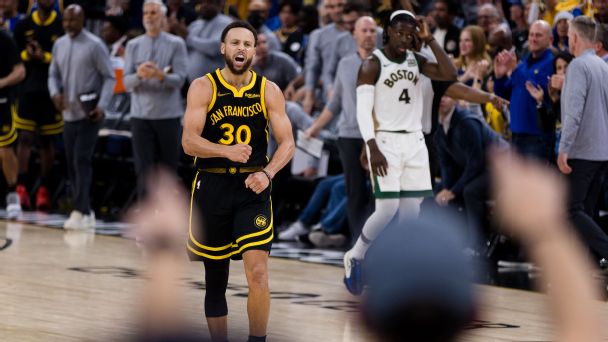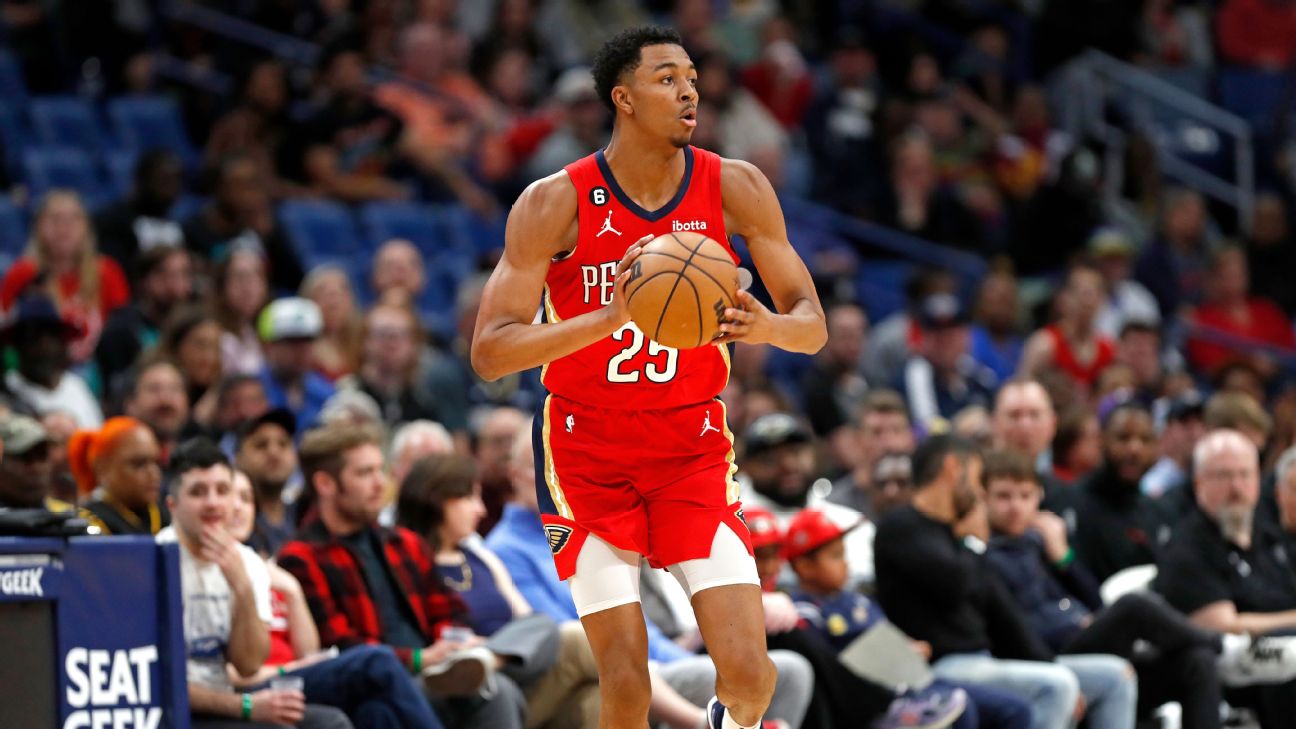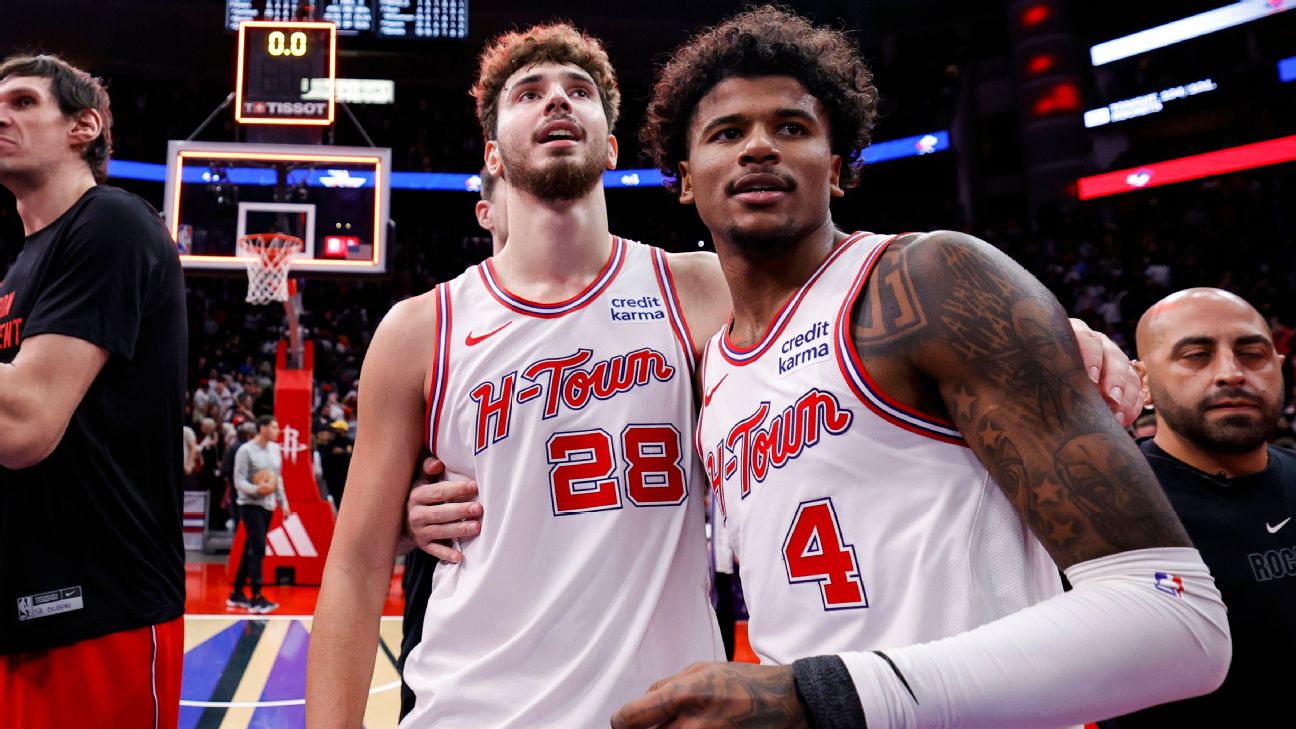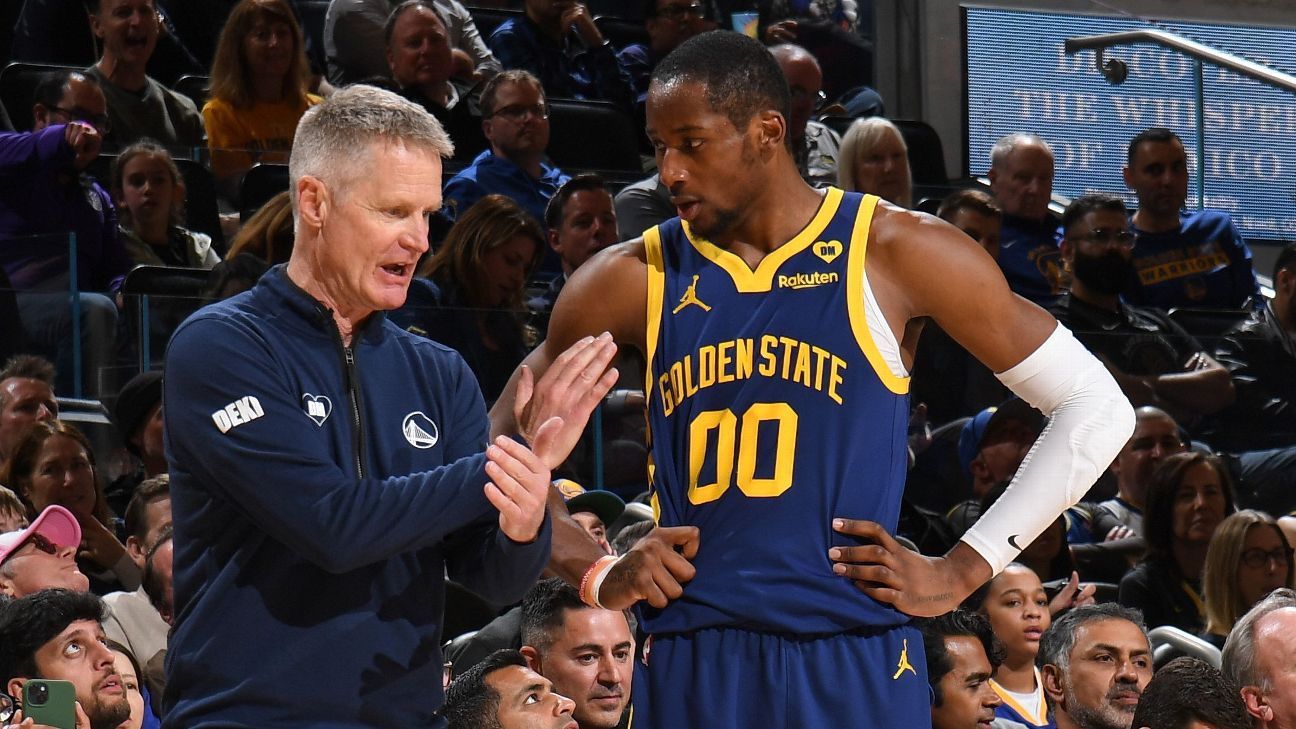It’s the Friday before Christmas, and that means … nine things I liked and disliked — Christmas edition! This week, we check in on the Golden State Warriors after Draymond Green’s suspension, the undeniable offensive chemistry that’s developing in Milwaukee and how the MVP front-runner and a GOAT candidate keep opponents guessing.
| Giannis-Dame chemistry
Unpredictable Embiid/LeBron | When Celtics get it moving
Nuggets finding right pace | Quickley learning from Brunson
Suns should bottle this | Thunder’s fallow periods | KAT on the tightrope

1. The adaptability of the Golden State Warriors
Good teams are more adaptable than you perceive in a crisis moment. The Warriors are 3-1 since the league announced an indefinite suspension for Draymond Green, now only two games in the loss column out of the No. 7 seed in the Western Conference.
Their defense has suffered without Green’s sneering ubiquity, but their offense is humming — slower and more risk averse, yet retaining some of the stylistic elements that have always made these Warriors stand out.
Those four games comprise four of Golden State’s nine most efficient performances, per Basketball-Reference. For a decade, Green has been the co-pilot of Golden State’s beautiful game — pushing in transition, barking at cutters, partnering with Stephen Curry in a two-man game that requires only winks and nods between them. And yet, the Warriors’ offense has never suffered any drop-off when Curry plays without Green.
They have mostly forsaken the transition game; their pace over those four games would rank 29th overall.
Their half-court offense doesn’t look much different. They have not defaulted to standard pick-and-roll fare. Curry’s pick-and-roll volume is unchanged, per Second Spectrum. They still cut, run shooters through thickets of screens and use post-ups to activate their trademark split actions.
But there is more deliberateness. Both Curry and Chris Paul are touching the ball more, and holding it longer. There is more semi-scripted organization, less weaponized chaos:
That’s a designed play — a Curry pick-and-roll, with Paul sliding up to the elbow as a release valve. The idea is for Curry to draw a trap, ping it to Paul and let the Point God scan the floor. No one is open, so Paul makes use of his old reliable midrange jumper.
The Warriors’ turnover-itis has subsided — for now. They have only 49 cough-ups across those four games.
Oh, the chaos is still there. It is embedded in the fabric of this team.
That play starts from the same underlying principle, this time with Klay Thompson as the release valve after Curry entices the trap. Thompson drives and kicks Andrew Wiggins, but the defense runs Wiggins off the arc. Watch Thompson. Most players would continue along and jog over to the left corner. Not Thompson. He stops under the rim and moonwalks to the right corner instead. The defense has no clue where he is.
Thompson is finding his equilibrium: He’s averaging 26.5 points on 51% shooting since Green’s suspension. He’s up to 38% on 3s. He has also dished 13 assists over those four games, and both the Warriors and Thompson are always better when he makes the simple play. Thompson’s passing is a secret bellwether.
The Warriors have amped up their offensive rebounding with Trayce Jackson-Davis snagging more minutes. He ranks fifth leaguewide in offensive rebounding rate. Jonathan Kuminga is playing with a new calm. Brandin Podziemski is ready for anything.
There is a long way between here and the postseason, let alone title contention. The Warriors need Green to hit their two-way zenith. Reintegrating him might disrupt their rhythm.
and Damian Lillard have undeniable chemistry
Psst: The Milwaukee Bucks have the No. 1 offense over their past 20 games, and sit just a half-game behind the Boston Celtics for the East’s top seed. They might not run as much Lillard-Antetokounmpo pick-and-roll as anyone envisioned, but the current formula is working.
After an uncertain first 10 games, the Bucks have unleashed hell in transition — one place where their superstars enjoy undeniable chemistry. Antetokounmpo loves to grab and go, and he has never had a shooting threat like Lillard running with him:
(That’s a nice screen from Andre Jackson Jr., who is getting more run lately and brings the length and defense Milwaukee so sorely needs on the wing. He’s also 11-of-24 from deep. The Bucks need to test out whether Jackson and MarJon Beauchamp might be ready for real playoff minutes.)
Gander at all the space Antetokounmpo and Brook Lopez have up the middle in semi-transition with Lillard, Khris Middleton, and Malik Beasley dotting the arc:
Milwaukee is running only 16.5 Lillard-Antetokounmpo pick-and-rolls per 100 possessions — about 10 per game. (Lillard has set only seven ball screens for Antetokounmpo. That should be a major asset, too.)
There are a bunch of reasons, good and bad, the Bucks have made middling usage of a potential tentpole play: typical chemistry hiccups, rotation patterns, and the coaching staff’s desire to test out other Lillard-centric combinations in which Antetokounmpo lurks as a cutter. But an underplayed reason is tapping into Lillard’s gravity as a spot-up gunner around Antetokounmpo’s actions, including the Antetokounmpo-Lopez two-man game.
The Bucks discovered that teams would overplay the Lillard-Antetokounmpo pick-and-roll when they saw it coming — blitzing Lillard and swarming Antetokounmpo. Antetokounmpo’s only option would be kicking out for 3s.
Those are solid shots, though defenses whittle away the efficiency by snuffing the corners and rotating on time. But they are higher-variance shots. They don’t yield free throws. Antetokounmpo and Lillard are all-time scorers; they want to start and finish possessions.
to the LA Clippers in what looks like a win-win trade.
Tyrese Maxey isn’t on Harden’s level as a distributor, but he’s growing every game. He is much faster than Harden, and that sheer speed allows him to engage Joel Embiid in different ways and from more places on the floor. They are discovering new tricks every quarter.
Embiid is averaging 7.6 post touches per 100 possessions, by far a career low, per Second Spectrum. Embiid’s migration to the free throw area began last season, but it has accelerated since. Working from there gives Embiid a clearer view of the entire floor and shortens the distance of some of his passes. Embiid is dishing a career-high six dimes. Everyone cuts with the verve you see when players know they might get the ball.
Here’s Embiid living up to the “unpredictable” mantra:
The Sixers get Ausar Thompson switched onto Embiid. Embiid sprints toward the paint as if to drag Thompson into a bulldozing post-up.
But it takes time to seal position and then for a teammate to thread an entry pass. Good defenses drain the shot clock by fronting. Embiid gives Philly more time by faking toward the paint and then hitting the brakes.
Embiid is averaging a career-high 15.5 isolations per 100 possessions. The Sixers have scored 1.21 points out of those plays — fourth among 88 guys who have run at least 50 isos this season, per Second Spectrum.
Embiid is averaging a league-best 35 points (!!) and has more points than minutes played. He also might be playing the best defense of his career. He’s challenging almost 11 shots around the basket, most in the league, and opponents have hit a measly 50% on those attempts. Those are the best numbers of Embiid’s career.
The Sixers are 19-8 with the league’s best net rating. Embiid is the MVP front-runner.
Here’s LeBron James pulling the same trick after the Austin Reaves-James two-man game gets James a mismatch:
James feigns going into isolation mode before dusting the entire defense.
That’s great. Here’s the reality: The Lakers — having lost four straight — are down to 24th in points per possession. The Washington Wizards have a higher offensive efficiency. The Lakers are 25th in 3-point shooting and 29th in offensive rebounding. They are not winning two and probably not even one playoff series with an offense in this state — if they make the playoffs. (The Lakers are eighth in the West, one game up in the loss column on the 11th-place Warriors.)
The only in-house solution is more Reaves and Rui Hachimura (and maybe Gabe Vincent). D’Angelo Russell has had a miserable December and brings zero oomph. Reaves has cracked 30 minutes in just three of the Lakers’ past 12 games.
, and I love that high-arching lead pass from Jayson Tatum to Derrick White. It starts a cascade that ends with Brown getting a wide-open 3. Tatum throws it on the run and keeps sprinting while it’s airborne. (White is averaging 16.5 points, 5 rebounds and 4 assists on almost 50/40/90 shooting, playing his usual hounding defense. Does he have an All-Star case?)
That doesn’t lead to a shot, but there is something quietly beautiful and efficient about it. Kristaps Porzingis rebounds that miss near the baseline, and the ball does not touch the floor until Tatum dribbles well after crossing half court.
finding the right pace
The champs are third in the West and just sixth overall in net rating, but they remain clear favorites to make the Finals — even conceding the conference’s current top seed, the Minnesota Timberwolves, plays Denver well.
The Nuggets have obliterated opponents by 15 points per possession with Jamal Murray and Nikola Jokic on the floor. There is no answer for the Murray-Jokic two-man game, all staccato dribbles and in-between shots that shouldn’t be efficient but somehow are. Denver’s starting five is the league’s most complete playoff-tested lineup. Each player complements the other four, amplifying strengths and covering up weaknesses.
There will be off nights, but Denver’s young bench is slowly rounding into form. Julian Strawther is a two-way playmaker. Peyton Watson wants to swat your shot through the floor and is 7-of-11 from deep over his past four games.
The Nuggets have been a slow-paced team for most of the Jokic era, but they have slowed an extra tick: Their pace is down, and they are taking longer to shoot after makes, misses and live-ball turnovers, per Inpredictable. Murray and Jokic make art jabbing at defenses, but the Nuggets are at their best when they hunt transition chances with more purpose.
It activates Jokic’s bonkers outlet passing, and gets their support players easy looks. Heck, they might actually get fouled: Denver is 26th in free throw rate, and their frustration has boiled over into technical fouls.
The energy from fast-break plays ripples across the roster. Denver’s defense hits another gear. A half-court scoring machine tossing in extra fast-break buckets is demoralizing for opponents.
The Nuggets’ transition game has been a little ragged by their standards. They somehow rank dead last in points per play on transition chances, according to Cleaning the Glass. That shouldn’t even be possible with Jokic heaving water polo outlets.
Aaron Gordon indulges in the occasional early-clock triple in semi-transition:
Gordon is such a defensive stalwart, you want to give him some leeway to chase points. It’s good for Denver if he takes a certain number of wide-open dare 3s in the half court. But this is a different variant of 3-pointer, and the Nuggets would be better served if Gordon — 26% on 3s this season — bagged most of them and let the offense flow.
has learned a thing or two from Jalen Brunson
After a slow start, Quickley’s numbers are back where they were last season — when he was my choice for Sixth Man of the Year. (Ignore what happened in the playoffs!) His defense has been better. Once again, the New York Knicks are mauling teams when Quickley plays alongside Jalen Brunson and Josh Hart in go-go hybrid lineups; New York is plus-19 per 100 possessions with those three on the floor.
Brunson might be the best and most frequent user among guards of the fake handoff. Quickley has mastered it, too:
That’s worthy of an old-school Chris Berman “Whoop!”
Quickley adds some needed chaos to New York’s battering-ram offense:
Taurean Prince doesn’t fall for the quarterback keeper, but Quickley pivots into a whir of bobs and weaves until something cracks.
The East’s No. 4 seed is up for grabs. The Knicks might have been the favorite for it before Mitchell Robinson, their most valuable defender and a one-man offensive rebounding team, suffered an ankle injury that will require surgery. The Knicks have three centers left in Isaiah Hartenstein, Taj Gibson and Jericho Sims, but that’s not cutting it against elite teams.
It will be interesting to see how Robinson’s injury impacts New York’s approach at the trade deadline. Do the Knicks use assets once earmarked for a bigger trade to fill their center spot? (Hartenstein is a free agent after this season.) Do they aim more at next season and beyond rather than making a push in this one?
A megadeal for Donovan Mitchell would help on both timelines, but the Cleveland Cavaliers — just one game behind the Knicks — have shown no inclination to discuss Mitchell trades at this point, per league sources. That might not change unless Mitchell expresses some imminent unhappiness in Cleveland.
New York is already built around an undersized, ball-dominant, All-Star-level guard in Brunson. Is it worth it to use all their chips to pair Brunson and Mitchell (assuming Cleveland has any interest in what the Knicks have to offer)? In theory, perhaps not. In reality, even big-market teams can’t wait forever for the perfect superstar. In the past three months, the Knicks have watched both Embiid and Antetokounmpo go from “maybe available soon-ish” to “putting up MVP-level numbers on remade contenders.” (Antetokounmpo just signed another extension.) We also have proof of concept — via the Dallas Mavericks and Luka Doncic — that Brunson can thrive next to another star ball handler.
And if the theoretical Mitchell-Brunson duo were to plateau, the Knicks could turn around and trade one for a bounty. The bet here is that the Knicks would express some interest in Mitchell if the Cavs ever entertained the conversation, but Cleveland isn’t there yet.
thing
At some point, we will see the real Phoenix Suns … right? You know, the team for whom Phoenix traded Mikal Bridges, Cameron Johnson, Paul and a gazillion first-round picks — some of which have been divided into swap rights more times than Voldemort split his soul.
When that happens, several Suns — but especially Bradley Beal — need to bottle what Goodwin is doing:
Only Jusuf Nurkic, Drew Eubanks and Kevin Durant have set more screens among Phoenix players than Goodwin. A willing guard screener — someone who can shoot 3s and make plays in space — opens up so many options. Against the best Phoenix lineups, a lot of defenses will stash their point guards on Beal. That should trigger a good number of Durant-Beal and Devin Booker-Beal pick-and-rolls as a vehicle to generate switches and mismatches.
executive vice president and general manager Sam Presti cautioned before the season that it was premature to discuss the Thunder cashing in its bundle of future picks in a win-now mega-trade. He pointed out that last season’s feel-good team still finished under .500. Both Presti and head coach Mark Daigneault framed this season as one of “discovery” — of learning whether this team could leap .500, and what it might need going into the mid-2020s.
Two months later, the Thunder are No. 2 in the West — 18-8, with the league’s third-best point differential. Perhaps Presti would warn today that 26 games can only tell us so much — that these Thunder will face adversity at some point.
But by any measure, the Thunder profile as a contender. That is unusual for a team that in its present form has not made the playoffs, and Thunder higher-ups might point to that as a huge missing data point: The playoffs are different. How does this group look there?
Shai Gilgeous-Alexander is a superstar in any setting, but the Thunder haven’t yet figured out a scoring formula when he rests. They have scored 120 points per 100 possessions with Gilgeous-Alexander on the floor and just 109.7 when he sits — the difference between the No. 3 and No. 26-ranked team offenses.
Their free throw and offensive rebounding rates crater without Gilgeous-Alexander wearing out a path to the basket. They get way fewer shots at the rim. Their turnovers spike.
Oklahoma City has tried just about every plausible lineup combination in those minutes, including using both Jalen Williams and Chet Holmgren. Even that has not worked. Williams is awesome — a future All-Star, probably — but he has not quite been up to running the show as a No. 1 option. (He’s 22!)
Holmgren has both an All-Star and Defensive Player of the Year case, but some defenses take his jumper away by guarding him with wings — and hiding their centers on some of Oklahoma City’s less dangerous backups. Josh Giddey used to be a mainstay of these lineups; his minutes are down across the board.
Isaiah Joe’s shooting would loosen spacing for reserve-heavy groups, but he has played about 80% of his minutes with Gilgeous-Alexander for that same reason — and to maximize their killer two-man game.
This is not a huge problem. The Thunder are awesome. Gilgeous-Alexander will push 40 minutes in close playoff games. But it’s something to monitor.
has had a wonderful seven months as part of the best Minnesota team in two decades. He turned something of a corner in the final three games of their first-round series against Denver, scoring efficiently and competing with new urgency as the Wolves — without Naz Reid and Jaden McDaniels — put up a real fight.
Only time will tell if that week marked the end of what had been a troubling streak of low-scoring, high-foul postseason games. The pressure of this coming postseason — the pressure of expectations — will be like nothing Towns has experienced in the NBA.
He has adapted well to the double challenge of Minnesota adding one perimeter scorer above him in the hierarchy (Anthony Edwards) and a second big man in Rudy Gobert who owns the paint. Towns has found the right spots to score, and is up to 22 points on 50/40/90 shooting.
But he’s tempting fate — and humiliation — by doing this once every couple games:
I call that a tightrope rebound. It gives me visceral anxiety shakes. Just let it go out of bounds! The basketball gods will eventually punish Towns with some pratfall turnover.
You have a max deal that runs through 2028! You don’t need to pad your rebounding totals! And these are not situations where keeping the ball live carries some benefit; the defense is back and set.



